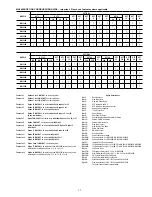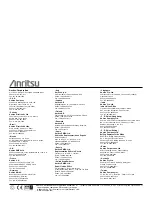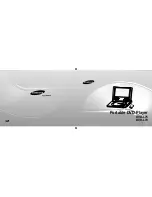
11
TRACE A: Ch1 8PSK Meas Time
1.5
-1.5
-1.9607643757
1.96078437567
I - Q
300
M
/div
MG3700A
MG3690B
Carrier Frequency = 38.000 GHz
RF
IF
LO
IF Up-Conversion (Option 7) Application and Setup
IF Up-Conversion (Option 7)
Option 7 adds an internal mixer that can be used for the generic up-conversion of
an IF signal. The mixer’s RF, LO, and IF ports are made available at the rear panel
of the MG3690B, via three female K-Connectors. The typical application will feed the
MG3690B microwave output, which can be moved to the rear panel via option 9K,
to the mixer’s LO port. An external IF signal will be fed to the mixer’s IF port. The
new up-converted signal will be available at the mixer’s RF port.
The IF Up-Conversion option is particularly useful to create a microwave frequency
IQ-modulated signal. Lower frequency IQ-modulated RF sources are readily avail-
able, such as the Anritsu MG3681A. Option 7’s IF input can be used to feed in an
IQ-modulated signal from an MG3681A, up-converting it to as high as 40 GHz with
an MG3694B. A typical setup is shown below.
User-Defined Modulation Waveform Software (Option 10)
An external software package provides the ability to download user-defined wave-
forms into the internal LF Generator’s (Option 27) memory. The MG3690B provides
as standard with the LF Generator sinusoidal, square-wave, triangle, positive ramp,
Gaussian noise, and uniform noise waveforms.
Two look-up tables of 65,536 points can be used to generate two pseudo-random
waveforms, one for amplitude modulation and the other for frequency or phase
modulation. The download files are simple space-delimited text files containing inte-
ger numbers between 0 and 4095, where 0 corresponds to the minimum modulation
level and 4095 the maximum.
In addition to the capability of downloading custom waveforms, the software
offers a virtual instrument modulation panel. Custom modulation setups with user
waveforms can be stored for future use. For IFF signal simulation, the internal
generators can be synchronized. They can also be disconnected from the internal
modulators, making the low frequency waveforms available at the rear panel for
external purposes.
Scan Modulation (Option 20)
Option 20 adds a microwave linearly controlled attenuator to provide deep AM ca-
pability. This modulator is inserted outside the leveling loop but before the optional
step alternator. It is switched in and out of the RF path. Scan modulation is driven
externally only.
One application of this feature is storing an antenna pattern wave form in memory
and using it to feed the external input to the scan modulator, Option 20.
Mixer Type
Double Balanced
RF, LO Range
1 to 40 GHz
IF Range
DC to 700 MHz
Conversion Loss
10 dB Typical
Max Power into any Port
30 dBm
Isolation, RF to LO
23 dB
LO Drive Level (recommended)
+10 to +13 dBm
Input P
1 dB
+3 dBm Typical
Frequency Range
2 to 18 GHz
Attenuation Range
0 to 60 dB
Flatness/Accuracy
±1.5 dB/±1.5 dB, 0 to 40 dB
±3 dB/±2 dB, 40 to 60 dB
Step Response
< 1
µ
s
Sensitivity
–10 dB/V
Modulation Bandwidth
20 kHz (small signal)
5 kHz (large signal)
Insertion Loss
< 6 dB (when engaged)
Input
Rear Panel BNC connector
High Impedance






































